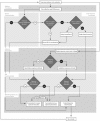Setting Occupational Exposure Limits for Chemical Allergens--Understanding the Challenges
- PMID: 26583909
- PMCID: PMC4685595
- DOI: 10.1080/15459624.2015.1072277
Setting Occupational Exposure Limits for Chemical Allergens--Understanding the Challenges
Abstract
Chemical allergens represent a significant health burden in the workplace. Exposures to such chemicals can cause the onset of a diverse group of adverse health effects triggered by immune-mediated responses. Common responses associated with workplace exposures to low molecular weight (LMW) chemical allergens range from allergic contact dermatitis to life-threatening cases of asthma. Establishing occupational exposure limits (OELs) for chemical allergens presents numerous difficulties for occupational hygiene professionals. Few OELs have been developed for LMW allergens because of the unique biological mechanisms that govern the immune-mediated responses. The purpose of this article is to explore the primary challenges confronting the establishment of OELs for LMW allergens. Specific topics include: (1) understanding the biology of LMW chemical allergies as it applies to setting OELs; (2) selecting the appropriate immune-mediated response (i.e., sensitization versus elicitation); (3) characterizing the dose (concentration)-response relationship of immune-mediated responses; (4) determining the impact of temporal exposure patterns (i.e., cumulative versus acute exposures); and (5) understanding the role of individual susceptibility and exposure route. Additional information is presented on the importance of using alternative exposure recommendations and risk management practices, including medical surveillance, to aid in protecting workers from exposures to LMW allergens when OELs cannot be established.
Keywords: allergens; asthma; chemicals; exposure; occupational; sensitization.
Figures


References
-
- Kimber I. Basketter D.A. Dearman R.J. Chemical allergens–what are the issues? Toxicology. 2010;268(3):139–142. - PubMed
-
- Kimber I. Basketter D.A. Thyssen J.P. Dearman R.J. McFadden J.P. Chemical allergy in humans: fresh perspectives. J. Immunotoxicol. 2014;11(3):203–204. - PubMed
-
- Janeway C.A. Jr. Travers P. Immunobiology: The Immune System in Health and Disease. Vol. 12. New York: Garland Publishing Inc; 1997. Allergy and hypersensitivity; pp. 11–11.
-
- Kimber I. Basketter D.A. Gerberick G.F. Ryan C.A. Dearman R.J. Chemical allergy: translating biology into hazard characterization. Toxicol. Sci. 2011;120 Suppl 1:S238–268. - PubMed
-
- Enk A.H. Allergic contact dermatitis: understanding the immune response and potential for targeted therapy using cytokines. Mol. Med. Today. 1997;3(10):423–428. - PubMed
MeSH terms
Substances
Grants and funding
LinkOut - more resources
Full Text Sources
Other Literature Sources
Medical
